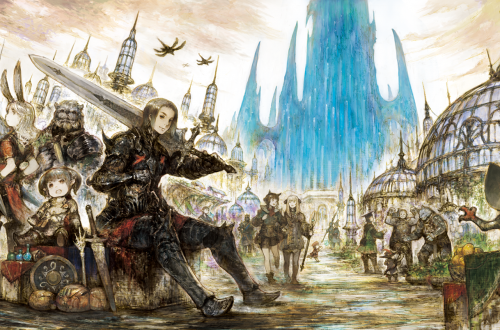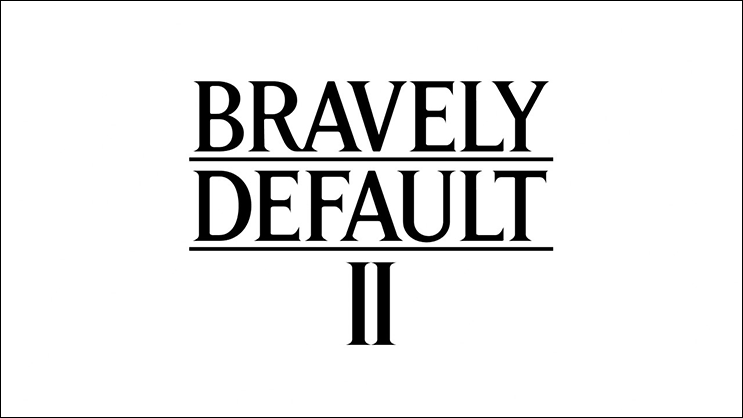
The Power of Sustain in Bravely Default 2’s Combat System
Combat in Bravely Default 2 is a little different than what you may be used to—first of all, it’s turn-based combat, but the game also uses a Brave and Default mechanic that you may have never heard of before. In combat, you save up Battle Points (BP) by using “Default” (think of Default as a defense battle command), and once you’ve built up enough BP (2-3), you can use them all up to attack several times in a row using “Brave”. You could, for example, save up BP to string together a chain of up to four moves when you’re in a tough bind—use a Phoenix Down on a fallen party member, use a Potion or healing spell to restore their HP, and then attack the enemy twice. If you don’t have enough BP saved up, you could go into the negatives, but once you do so your character is unable to move for several turns until their BP is restored to 0. There are so many different combinations that you can use, it’s worth mentioning however that expending all of your BP at once may not always be the best idea.
Team Compositions
There are also several different jobs and abilities to mix and match in Bravely Default 2; a White Mage can use abilities like Firaga in battle if you set up your sub-class to Black Mage. Your party members can equip any job, but some handle certain roles better than others, and you can change them as often as you like to get the upper hand on your foes. Every job has 12 levels, and at every level, you’ll unlock a new ability for that job. You can use any active abilities previously learned on your main or sub-jobs. Passive (green) abilities, once unlocked for a character, can be assigned regardless of that character’s current job.
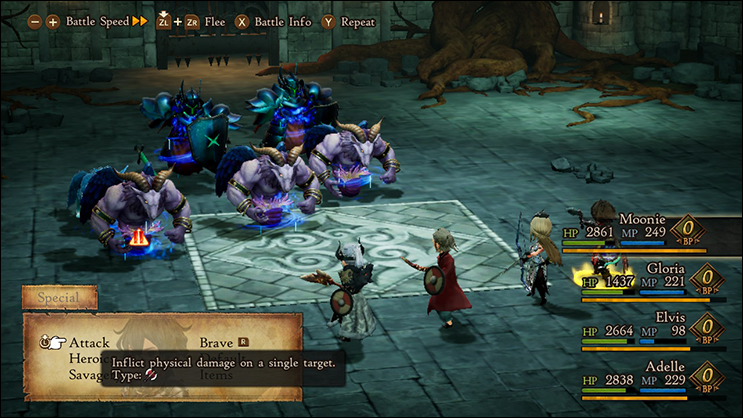
For example, if a White Mage has learned the Black Mage passive “Lunar Powered” and they also know the level 5 White Mage ability “Solar Powered”, they can restore MP every time in combat whether it be night or day on the battlefield—the ultimate MP-restore combo. Beyond that, each job has two “specialties,” or perks. The first is generally helpful, and the second, which unlocks when you max out a job at level 12, is often a game-changer. You’ll only earn job points (JP)—basically, experience points that level up the character’s job but not their overall level—for whatever role is currently set as the main job after every battle (or by using other items called JP Orbs in the game to increase JP outside of combat). The main job dictates whatever that character’s special ability is.
Bravely Default 2 has 4 characters: Seth, Gloria, Elvis, and Adelle. Seth, the main character, is an overall well-rounded character perfectly suited for just about any job you set him to, but is best at physical roles. Gloria and Elvis are a bit slower, and are at their best when assigned to a magic-user class like White Mage or Black Mage due to their low physical attack stats. Adelle is the best bruiser/tank you’ve got on your team. She has the most health (HP), and so she can take a lot of hits if set to the right job like Vanguard or Shieldmaster. But since her physical attack is so naturally high, setting her to a physical powerhouse such as Monk is a good idea, too, and she’ll beat the crap out of anything and everything.
But, again, any character can equip any job, so you can really experiment with this. Just remember that assigning a job to a character doesn’t affect the stats (character attributes) to a certain degree beyond their based character stat values. Gloria doesn’t make a great Monk, okay? I tried it.
Related: Bravely Default II: You Won’t Want to Put it Down
Since each character has their own set of attributes and they each contribute to every fight uniquely in their own way, this opens the door for a lot of customization. To save you some trial and error, here are some builds I’ve had fun with. My favorite though? Sustaining through a boss fight and watching the enemy boss slowly drain MP to the point where they run out of MP and can’t use abilities or counterattack. Yeah, you can’t go in all-ham and beat the boss to a pulp right off the bat (I mentioned this a little bit in my review), but it makes for a really interesting fight, and it always feels equally rewarding watching the boss try to counterattack with a super powerful magic ability to see “Out of MP” and nothing happens. Give it a spin. It’s a lot of fun, I promise.
The Ultimate Sustain
Like I said, this may be my favorite team composition, and you can do this in a few different ways. Set Adelle to Vanguard or Berserker and be sure to know the Vanguard ability “Aggravate”. You’ll draw enemies to target her first (yeah, there’s an enmity system in this game!) Set her to Vanguard if the enemy does a lot of damage (it’s a bit tankier), and Berserker with Vanguard as the sub-job. Shieldmaster is a decent option especially if the enemy does a ton of damage, but always be sure to have Aggravate available. It leaves the rest of the team to heal and attack.
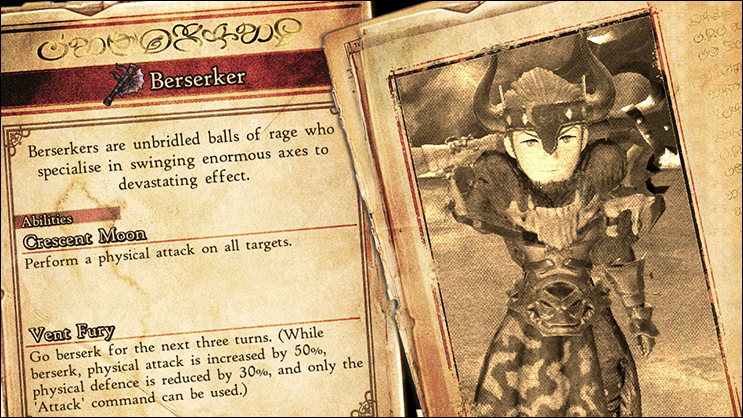
Gloria is almost always my healer, and Elvis is always primarily my magical damage dealer; you’ll find Red Mage to be super helpful in this party composition since they can heal. In this particular party composition, you’ve got a few options for the main character. Typically, I set the main character as a Berserker and the sub-job to Thief if the enemy is a magic-caster. Berserker allows you to penetrate the enemy’s Default stance (also big damage!), and sometimes it’s fun to set the sub-job to Thief to steal MP from the boss—slowly drain their MP to stop those (*ahem) STUPID ANNOYING COUNTER SPELLS! Seth can be a little squishy and might need some extra healing, but that’s what equipping accessories are for (extra HP!)
Waiting for a boss to drop their MP to 0 takes some time and dedication, but if my team is slightly under-leveled, I find that this strategy works flawlessly every time.
Magic Points (MP) Sustain
Set Gloria to White Mage, and you’ve got some flexibility with her sub-job. I like setting her sub-job as another casting class in most boss fights, and if she knows Drain Attack from White Mage, she’ll heal a little HP any time she attacks the enemy. Like I said before, you can equip passive abilities, too. Try learning some abilities from Beast Master, namely MP Saver, to reduces MP consumption by 20% (with MP Saver equipped and Lunar/Solar Powered equipped, you’ll never run out of mana!). At level 11, White Mage learns their passive ability “Better Than Ever”: when the user is healed beyond max. HP, the max. HP is temporarily increased by the remainder. She won’t die. Ever. It’s brilliant.
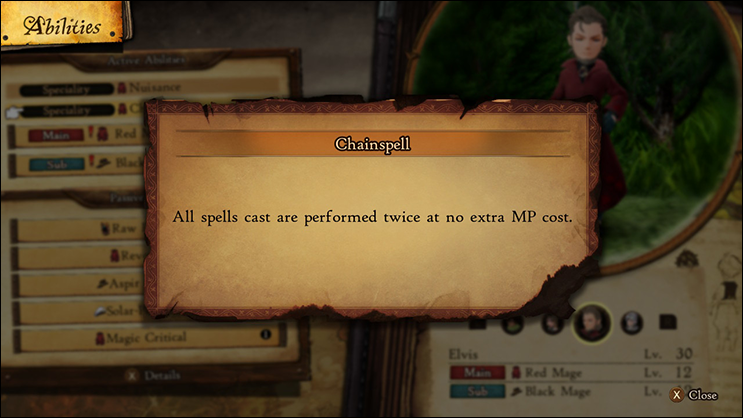
Elvis can be assigned to Red Mage with the ability “Revenge” equipped to earn extra BP if the enemy hits him. Also, if Red Mage is maxed at job level 12, they learn an additional ability called “Chainspell”. This ability allows the user to cast a spell twice without the additional MP cost. You can see how beneficial this would be if you’re relying heavily on magical attacks.
High-level spells tend to burn MP. At level 10, a Beastmaster will unlock the MP Saver ability (mentioned above for Gloria), which periodically reduces the costs of spells by 20 percent in combat. With that ability equipped, Disaster—a comically powerful Red Mage move that costs 100 MP—suddenly becomes more viable. MP Saver also makes it slightly easier to spam the three high-level Black Mage spells: Firaga, Blizzaga, and Thundaga. I initially gave the Beastmaster job a test drive purely to unlock the MP Saver ability. Turns out, Beastmasters are extremely fun—and pretty good, too, particularly as a sub-job.

Tip for Mages: With any magic user, you should strive to unlock and assign both the Solar-Powered and Lunar-Powered abilities, which you get at level five for White Mage and Black Mage respectively. These will restore a modest chunk of MP depending on the time of day. Get both, and you’ll keep your MP afloat whether or not it’s day or night.
No Tank?
There’s a particular boss fight that counters White Mage attacks and it obliterated me on my first try. It’s like the devs knew what I was up to. Anyway, for this particular fight, I set Adelle and Seth to Berserker, kept Elvis as Red Mage (heals!…you have to know Healara and Healaga, learned at job level 6 and 9 respectively), and Gloria was my Ranger with the ability Humanoid Slayer learned (job level 8) to deal extra damage to Humanoid monsters. This particularly fight took a lot of patience and phoenix down (only White Mage knows raise spells), but we eventually pulled through it. I didn’t have Thief equipped to steal mana, but the boss ran out of MP near the end anyway, so it ultimately got easier and I had enough ether’s to restore Elvis’s MP.
Sometimes, you have to equip your team with HP-enhancing accessories and equipment to coast them through an abundance of combat status ailments (like poison), but you don’t necessarily need a tank because the boss uses AOEs (“area of effect”…multiple target attacks) and using a spell like Aggravate to attract damage to one character just won’t work. I like that about this game—abusing the system with White Mage won’t always work, and you’ll have to adjust for it. You’ll have to get crafty with other healing abilities, such as Red Mage’s healing spells, or relying upon restorative items such as Hi-Potions. If you choose to use restorative items only, you’ll need to beat the boss before you run out of restorative items from your inventory, so that can be too risky (and expensive!) in most cases. You’re better off spending your pg (money) on weapons and armor.
Exploit Those Weaknesses!
This may not be the best team composition for boss battles due to the Ranger’s squishy Health and MP pool, but it’s great for grinding EXP/JP/PG on the map or in dungeons due to their high damage and knack for 1-hit KO damage output.
The Ranger job is stupid, and by stupid, I mean you can fell an entire mob pack if you’ve learned the right Ranger ability to exploit the enemy’s weakness. Rangers are skilled archers who can target enemy weakness and deal extra damage to monster-families: mentioned above, Humanoid Slayer, which deals extra damage to humanoid monsters, in addition to Bug-Slayer, Beast-Slayer, an ability that paralyses the enemy, and a multi-attack ability that will deal extra damage to paralyzed enemies.
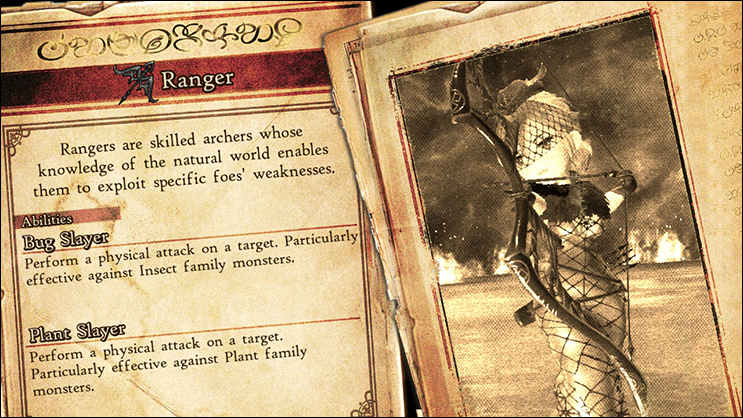
Set everyone to Ranger and go nuts in a dungeon. Since Ranger abilities cost MP, and Ranger doesn’t have a large MP pool, it may be worth stocking up on MP-restorative items such as mini-ether or ether, or just EXP grind next to a save point with some tents in your inventory to restore MP whenever you’re low. Ranger is a pretty squishy job so their health pool is really low too, so it may be worth setting at least one member of your team with restorative spells. Alternatively, Freelancer learns an ability called Treat at level 2, and it restores 20% of a target’s HP and 10% of their MP, so you could realistically set everyone’s sub-job as Freelancer to restore health whenever you need it.
In addition, ranger’s learn two great passive abilities that are worth nothing too. Counter-Savvy (job level 6) will enable the user to always evade physical counter abilities. Does not apply to magic and certain other abilities; Who Dare Wins (job level 9) enables the user to becomes more likely to inflict critical hits, and also immune to blindness when BP is at one or higher. This is a fun passive ability to equip with another high-physical damage dealer such as Monk, since Monk learns an ability called Invigorate that further increases their attack damage. by 15% for three turns.
At 38 hours of gameplay, I still haven’t picked up every single job available in the game, but I can’t wait to mix and match more jobs as I progress. Drop a comment below of your favorite party compositions!
Follow me on Twitter to get notifications on my published works here and elsewhere!




